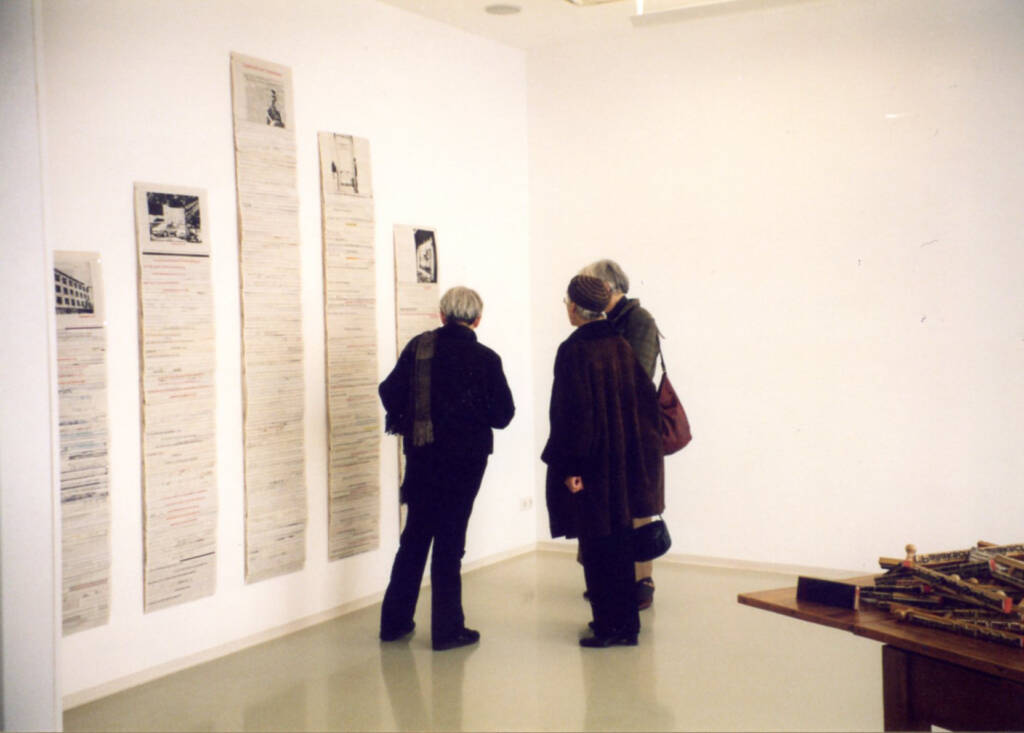
With:
Leila Danziger
Esther Shalev-Gerz
Simcha Shirman
Wojciech Prazmowski
Works of art and projects examining the systematic persecution and murder of the Jewish population by the Nazis in the “Third Reich” attract the attention of the art-interested public, not least because of the discussion about the erection of a memorial in Berlin for the murdered Jews in Europe, which has been going on for ten years. With the exhibition “Images of Remembrance and Disappearance”, the ifa gallery Berlin wants to contribute to this discussion. It will show works by artists who have, over years or for all their life, examined the incomprehensible events in an entirely unspectacular way, independently from all controversies and discussions, driven by an inner impulse or by their biography. The ifa gallery Berlin chores artistic positions that lay less emphasis on memory and remembrance in an abstract way but focus their artistic work on individual fates, like Leila Danziger (Brazil) and Esther Shalev-Gerz (Israel/France), or artists who include themselves in the context and use their own experiences and feelings as their subject, like Simcha Shirman (Israel) and Wojciech Prazmowsik (Poland).
Leila Danziger (born 1962) realizes the installation “Greifswalder Strafße 138” at the ifa gallery. This work is based on an article that has been published in the Berliner daily newspaper “Der Tagesspiegel”, entitled “Finding Traces: Day Nursery, Greifswalder Street 138”. Sophie Gutmann was a teacher at the Jewish day nursery in Greifswalder Straße 138 in Berlin. The article gives an account both of the author’s search for Sophie Gutmann and of Gutmann’s life and suffering. Leila Danziger employs writing and images, and creates an installation in which she – as an artist and Brazilian Jew – examines the life and fate of the person being traced. In her installation, she revives all facets of this individual fate. For her, the Holocaust is not mass destruction of humans but the murder of millions of individuals, with their personal hopes, loves, fears and sufferings.
Esther Shalev-Gerz (born 1948) repeatedly examined the problem of remembrance of the Holocaust. One of her latest works, which has been shown in the Sprengel Museum Hannover last year, and was then included in the permanent collection, is the video “Does Your Image Concern Me?”. The artist interviews two women about their recollections from the end of World War II; one of the women was an actress, the other one a prisoner in the concentration camp Bergen-Belsen. Each of them tells in a monologue about her grievous remembrances of war, persecution and death. Then, the artist mutually showed the videotapes to the women and filmed their reactions. Thus, she created a deeply affecting document, which in its pure focus on these two singular fates lets one experience the dimensions of the crime against millions of people.
Simcha Shirman (born 1947) examines the Holocaust in all his works. Being a child of survivors of the Holocaust determines all his life and work. “Dear Krystyna”, he calls the work that he will present at the ifa gallery Berlin. Krystyna is a young woman, whose portrait he found in an exhibition at the Auschwitz concentration camp in a series of portrait photos of murdered prisoners, and which accompanies him ever since. In his concept for the show, he writes: “Krystyna’s portrait is the starting point in this work. The letters to Krystyna enable me to clarify and clear the coping with questions of memory (personal and historical), erased memory, truth and fiction, object, portrait, sight, desire, fear and anxiety.”
Wojciech Prazmowski (born 1949) complements this artistic approach with an installation that puts his individual reflection and experience in the center of the work. When he grew up near Auschwitz as a child, the untouched area outside the camp served as a place for pleasure excursions for Polish families. It was years later, that he became aware of the situation, that he realized what the watchtowers and fences have once meant, and what had happened there. The deep shock that he went through after this discovery does not let him quieten until today. Wojciech Prazmowski, who is one of the most important Polish photographers of his generation, and had a single exhibition at the ifa gallery Berlin in 2000, dedicates his photographic work to remembrance and disappearance, to the once lived lives and the sufferings that are included in the presented images. He created a series of eight works, entitled “Auschwitz.Roll-call (Auschwitz.Appell)” (2003), in which he uses the for his photographic work typical method of double exposure and several layers of images. It shows shadowy images of barracks and fences in the Auschwitz concentration camp. As if out of fog, traces of human existence emerge, scar-ves, clothes, shoes. These pictures have a tight atmosphere, and evoke contemplation and the notion of the continuous presence of humans and prisoners.